Double-Glued Multi-Focal Bionic Compound Eye Camera
Abstract
:1. Introduction
2. Results and Discussion
2.1. Design and Manufacture of a Double-Glued Compound Eye Lens
2.2. Surface Morphology of the Double-Glued Compound Eye Lens
2.3. Characterization of the Optical Performance of the Double-Glued Compound Eye Lens
2.4. Application of the Double-Glued Compound Eye Lens
3. Conclusions
Author Contributions
Funding
Conflicts of Interest
References
- Cao, J.J.; Hou, Z.S.; Tian, Z.N.; Hua, J.G.; Zhang, Y.L.; Chen, Q.D. Bioinspired Zoom Compound Eyes Enable Variable-Focus Imaging. ACS Appl. Mater. Interfaces 2020, 12, 10107–10117. [Google Scholar] [CrossRef] [PubMed]
- Vannier, J.; Schoenemann, B.; Gillot, T.; Charbonnier, S.; Clarkson, E. Exceptional preservation of eye structure in arthropod visual predators from the Middle Jurassic. Nat. Commun. 2016, 7, 10320. [Google Scholar] [CrossRef] [Green Version]
- Greiner, B.; Ribi, W.A.; Warrant, E.J. Retinal and optical adaptations for nocturnal vision in the halictid bee Megalopta genalis. Cell Tissue Res. 2004, 316, 377–390. [Google Scholar] [CrossRef] [PubMed]
- Lee, G.J.; Choi, C.; Kim, D.H.; Song, Y.M. Bioinspired artificial eyes: Optic components, digital cameras, and visual prostheses. Adv. Funct. Mater. 2018, 28, 1705202. [Google Scholar] [CrossRef]
- Liu, H.; Huang, Y.; Jiang, H. Artificial eye for scotopic vision with bioinspired all-optical photosensitivity enhancer. Proc. Natl. Acad. Sci. USA 2016, 113, 3982–3985. [Google Scholar] [CrossRef] [PubMed]
- Kim, J.-J.; Liu, H.; Ashtiani, A.O.; Jiang, H. Biologically inspired artificial eyes and photonics. Rep. Prog. Phys. 2020, 83, 047101. [Google Scholar] [CrossRef] [PubMed]
- Keum, D.; Jang, K.-W.; Jeon, D.S.; Hwang, C.S.H.; Buschbeck, E.K.; Kim, M.H.; Jeong, K.-H. Xenos peckii vision inspires an ultrathin digital camera. Light Sci. Appl. 2018, 7, 80. [Google Scholar] [CrossRef] [Green Version]
- Cogal, O.; Leblebici, Y. An Insect Eye Inspired Miniaturized Multi-Camera System for Endoscopic Imaging. IEEE Trans. Biomed. Circuits Syst. 2017, 11, 212–224. [Google Scholar] [CrossRef]
- Lambrinos, D.; Möller, R.; Labhart, T.; Pfeifer, R.; Wehner, R. A mobile robot employing insect strategies for navigation. Robot. Auton. Syst. 2000, 30, 39–64. [Google Scholar] [CrossRef]
- Holzner, G.; Du, Y.; Cao, X.; Choo, J.; deMello, A.J.; Stavrakis, S. An optofluidic system with integrated microlens arrays for parallel imaging flow cytometry. Lab Chip 2018, 18, 3631–3637. [Google Scholar] [CrossRef]
- Ribeiro, J.F.; Costa, A.C.; Gomes, J.M.; Costa, C.G.; Goncalves, S.B.; Wolffenbuttel, R.F.; Correia, J.H. PDMS Microlenses for Optical Biopsy Microsystems. IEEE Trans. Ind. Electron. 2017, 64, 9683–9690. [Google Scholar] [CrossRef]
- Floreano, D.; Pericet-Camara, R.; Viollet, S.; Ruffier, F.; Brückner, A.; Leitel, R.; Buss, W.; Menouni, M.; Expert, F.; Juston, R.; et al. Miniature curved artificial compound eyes. Proc. Natl. Acad. Sci. USA 2013, 110, 9267–9272. [Google Scholar] [CrossRef] [PubMed]
- Dai, B.; Zhang, L.; Zhao, C.; Bachman, H.; Becker, R.; Mai, J.; Jiao, Z.; Li, W.; Zheng, L.; Wan, X.; et al. Biomimetic apposition compound eye fabricated using microfluidic-assisted 3D printing. Nat. Commun. 2021, 12, 6458. [Google Scholar] [CrossRef]
- Wang, Y.; Gong, Y.; Huang, S.; Xing, X.; Lv, Z.; Wang, J.; Yang, J.-Q.; Zhang, G.; Zhou, Y.; Han, S.-T. Memristor-based biomimetic compound eye for real-time collision detection. Nat. Commun. 2021, 12, 5979. [Google Scholar] [CrossRef]
- Ma, M.; Zhang, Y.; Deng, H.; Gao, X.; Gu, L.; Sun, Q.; Su, Y.; Zhong, X. Super-resolution and super-robust single-pixel superposition compound eye. Opt. Lasers Eng. 2021, 146, 106699. [Google Scholar] [CrossRef]
- Song, L.; Zhu, H.; Zheng, Y.; Zhao, M.; Tee, C.A.T.; Fang, F. Bionic compound eye-inspired high spatial and sensitive tactile sensor. IEEE Trans. Instrum. Meas. 2021, 70, 1–8. [Google Scholar] [CrossRef]
- Hu, X.; Zhu, J.; Hu, Q.; Zheng, J.; Yang, D.; Zhou, F.; Cheng, Y.; Yang, Y. Digital optofluidic compound eyes with natural structures and zooming capability for large-area fluorescence sensing. Biosens. Bioelectron. 2022, 195, 113670. [Google Scholar] [CrossRef]
- Zhang, S.; Wu, Q.; Liu, C.; Wang, T.; Zhang, H.; Wang, J.; Ding, Y.; Chi, J.; Xu, W.; Xiang, Y.; et al. Bio-inspired spherical compound eye camera for simultaneous wide-band and large field of view imaging. Opt. Express 2022, 30, 20952–20962. [Google Scholar] [CrossRef]
- Bae, S.I.; Kim, K.; Yang, S.; won Jang, K.; Jeong, K.H. Multifocal microlens arrays using multilayer photolithography. Opt. Express 2020, 28, 9082–9088. [Google Scholar] [CrossRef]
- Su, S.; Liang, J.; Li, X.; Xin, W.; Ye, X.; Xiao, J.; Xu, J.; Chen, L.; Yin, P. Hierarchical Artificial Compound Eyes with Wide Field-of-View and Antireflection Properties Prepared by Nanotip-Focused Electrohydrodynamic Jet Printing. ACS Appl. Mater. Interfaces 2021, 13, 60625–60635. [Google Scholar] [CrossRef]
- Zhang, Y.; Xu, H.; Guo, Q.; Wu, D.; Yu, W. Biomimetic multispectral curved compound eye camera for real-time multispectral imaging in an ultra-large field of view. Opt. Express 2021, 29, 33346–33356. [Google Scholar] [CrossRef]
- Li, J.; Wang, W.; Mei, X.; Pan, A. Designable Ultratransparent and Superhydrophobic Surface of Embedded Artificial Compound Eye with Extremely Low Adhesion. ACS Appl. Mater. Interfaces 2020, 12, 53557–53567. [Google Scholar] [CrossRef] [PubMed]
- Feng, X.; Liu, Y.; Dong, J.; Yu, Y.; Xing, Y.; Shu, F.; Peng, L.; Wu, Y. A Meniscus Multifocusing Compound Eye Camera Based on Negative Pressure Forming Technology. Micromachines 2023, 14, 420. [Google Scholar] [CrossRef]
- Liang, W.-L.; Pan, J.-G.; Su, G.-D.J. One-lens camera using a biologically based artifificial compound eye with multiple focal lengths. Optica 2019, 6, 326–334. [Google Scholar] [CrossRef]
- Xu, M.; Li, S.; Li, J.; Zhang, L.; Lu, H. Fabrication of a bionic compound eye on a curved surface by using a self-assembly technique. Opt. Express 2022, 30, 30750–30759. [Google Scholar] [CrossRef]
- Zhu, L.; Zhang, Y.L.; Sun, H.B. Miniaturising artificial compound eyes based on advanced micronanofabrication techniques. Light Adv. Manuf. 2021, 2, 7. [Google Scholar] [CrossRef]
- Lian, Z.J.; Hung, S.Y.; Shen, M.H.; Yang, H. Rapid fabrication of semiellipsoid microlens using thermal reflow with two different photoresists. Microelectron. Eng. 2014, 115, 46–50. [Google Scholar] [CrossRef]
- He, Q.; Liu, J.; Yang, B.; Dong, Y.; Yang, C. Fabrication and Characterization of Biologically Inspired Curved-Surface Artificial Compound Eyes. J. Microelectromechanical Syst. 2013, 22, 4–6. [Google Scholar] [CrossRef]
- Cherng, Y.S.; Su, G.D.J. Fabrication of polydimethylsiloxane microlens array on spherical surface using multi-replication process. J. Micromech. Microeng. 2014, 24, 5016. [Google Scholar] [CrossRef]
- Lin, T.H.; Hung, S.Y.; Hung, C.H.; Shen, M.H.; Chao, C.K.; Yang, H. A new fabrication method for an asymmetric microlens array light control film using inclined exposure and an incomplete thermal reflow process. J. Chin. Inst. Eng. 2015, 38, 787–796. [Google Scholar] [CrossRef]
- Jucius, D.; Grigaliūnas, V.; Lazauskas, A.; Sapeliauskas, E.; Abakevičienė, B.; Smetona, S.; Tamulevičius, S. Effect of fused silica surface wettability on thermal reflow of polymer microlens arrays. Microsyst. Technol. 2016, 23, 2193–2206. [Google Scholar] [CrossRef]
- Scheiding, S.; Yi, A.Y.; Gebhardt, A.; Li, L.; Risse, S.; Eberhardt, R.; Tünnermann, A. Freeform manufacturing of a microoptical lens array on a steep curved substrate by use of a voice coil fast tool servo. Opt. Express 2011, 19, 23938–23951. [Google Scholar] [CrossRef] [Green Version]
- Zhang, H.; Li, L.; McCray, D.L.; Scheiding, S.; Naples, N.J.; Gebhardt, A.; Risse, S.; Eberhardt, R.; Tünnermann, A.; Yi, A.Y. Development of a low cost high precision three-layer 3D artificial compound eye. Opt. Express 2013, 21, 22232. [Google Scholar] [CrossRef]
- Li, L.; Yi, A.Y. Development of a 3D artificial compound eye. Opt. Express 2010, 18, 18125–18137. [Google Scholar] [CrossRef]
- Li, L.; Yi, A.Y. Design and fabrication of a freeform microlens array for uniform beam shaping. Microsyst. Technol. 2011, 17, 1713–1720. [Google Scholar] [CrossRef]
- Wu, D.; Wang, J.N.; Niu, L.G.; Zhang, X.L.; Wu, S.Z.; Chen, Q.D.; Lee, L.P.; Sun, H.B. Bioinspired fabrication of high-quality 3D artificial compound eyes by voxe-modulation femtosecond laser writing for distortion-free wide-field-of-view imaging. Adv. Opt. Mater. 2014, 2, 751–758. [Google Scholar] [CrossRef]
- Zhai, Y.; Han, Q.; Niu, J.; Liu, J.; Yang, B. Microfabrication of bioinspired curved artificial compound eyes: A review. Microsyst. Technol. 2021, 27, 3241–3262. [Google Scholar] [CrossRef]
- Liu, Y.; Zhang, P.; Deng, Y.; Hao, P.; Fan, J.; Chi, M.; Wu, Y. Polymeric microlens array fabricated with PDMS mold-based hot embossing. J. Micromech. Microeng. 2014, 24, 095028. [Google Scholar] [CrossRef]
- Lian, G.; Liu, Y.; Tao, K.; Xing, H.; Huang, R.; Chi, M.; Zhou, W.; Wu, Y. Fabrication and characterization of curved compound eyes based on multifocal microlenses. Micromachines 2020, 11, 854. [Google Scholar] [CrossRef]
- Yi, J.; Baek, C.; Kim, J.; Koo, K.; Seo, J. Fabrication of a light screen-aperture integrated flexible thin film micro-lens array for a biomimetic superposition compound eye. Opt. Express 2021, 29, 39214–39226. [Google Scholar] [CrossRef]
- Luo, Y.; Wang, L.; Ding, Y.; Wei, H.; Hao, X.; Wang, D.; Dai, Y.; Shi, J. Direct fabrication of microlens arrays with high numerical aperture by ink-jetting on nanotextured surface. Appl. Surf. Sci. 2013, 279, 36–40. [Google Scholar] [CrossRef]
- Vespini, V.; Coppola, S.; Todino, M.; Paturzo, M.; Bianco, V.; Grilli, S.; Ferraro, P. Forward electrohydrodynamic inkjet printing of optical microlenses on microfluidic devices. Lab Chip 2016, 16, 326–333. [Google Scholar] [CrossRef] [PubMed]
- Tao, K.; Lian, G.; Liu, Y.; Xing, H.; Xing, Y.; Su, X.; Feng, X.; Wu, Y. Design and integration of the single-lens curved multi-focusing compound eye camera. Micromachines 2021, 12, 331. [Google Scholar] [CrossRef] [PubMed]
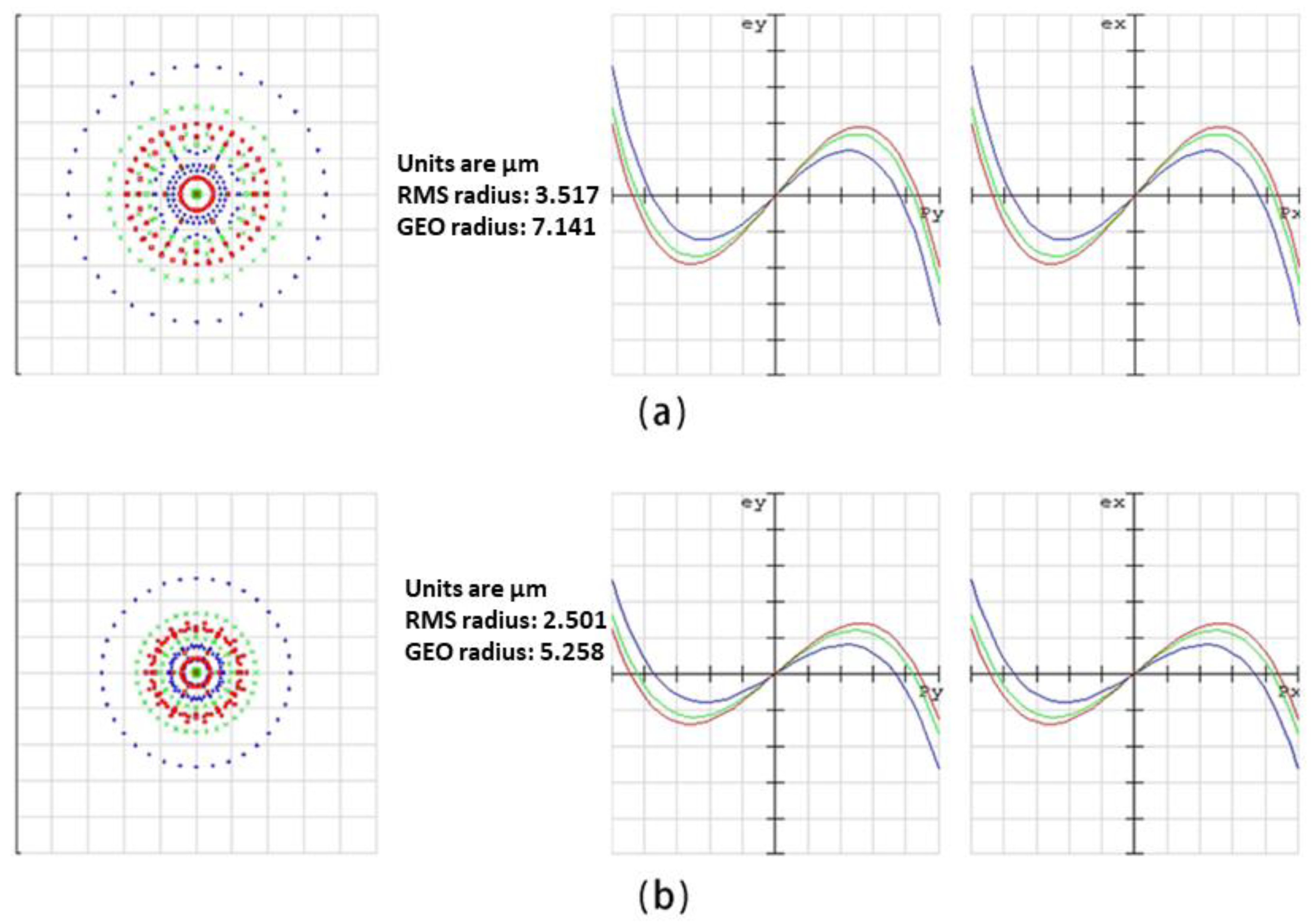
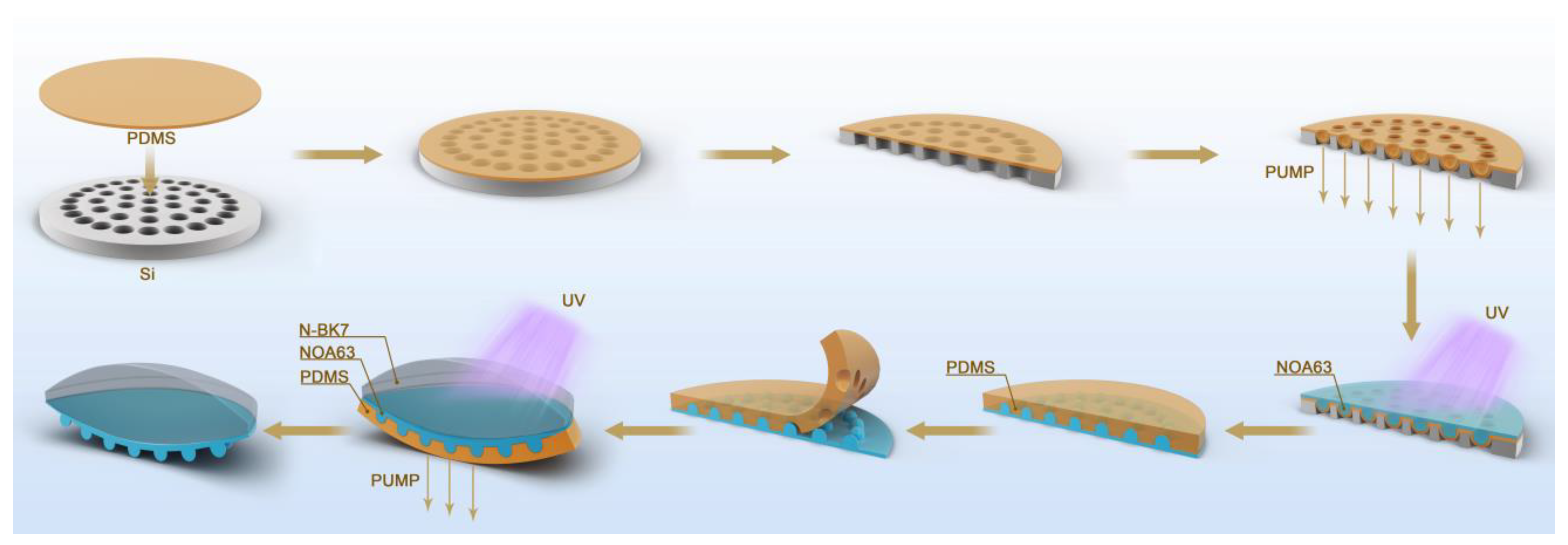

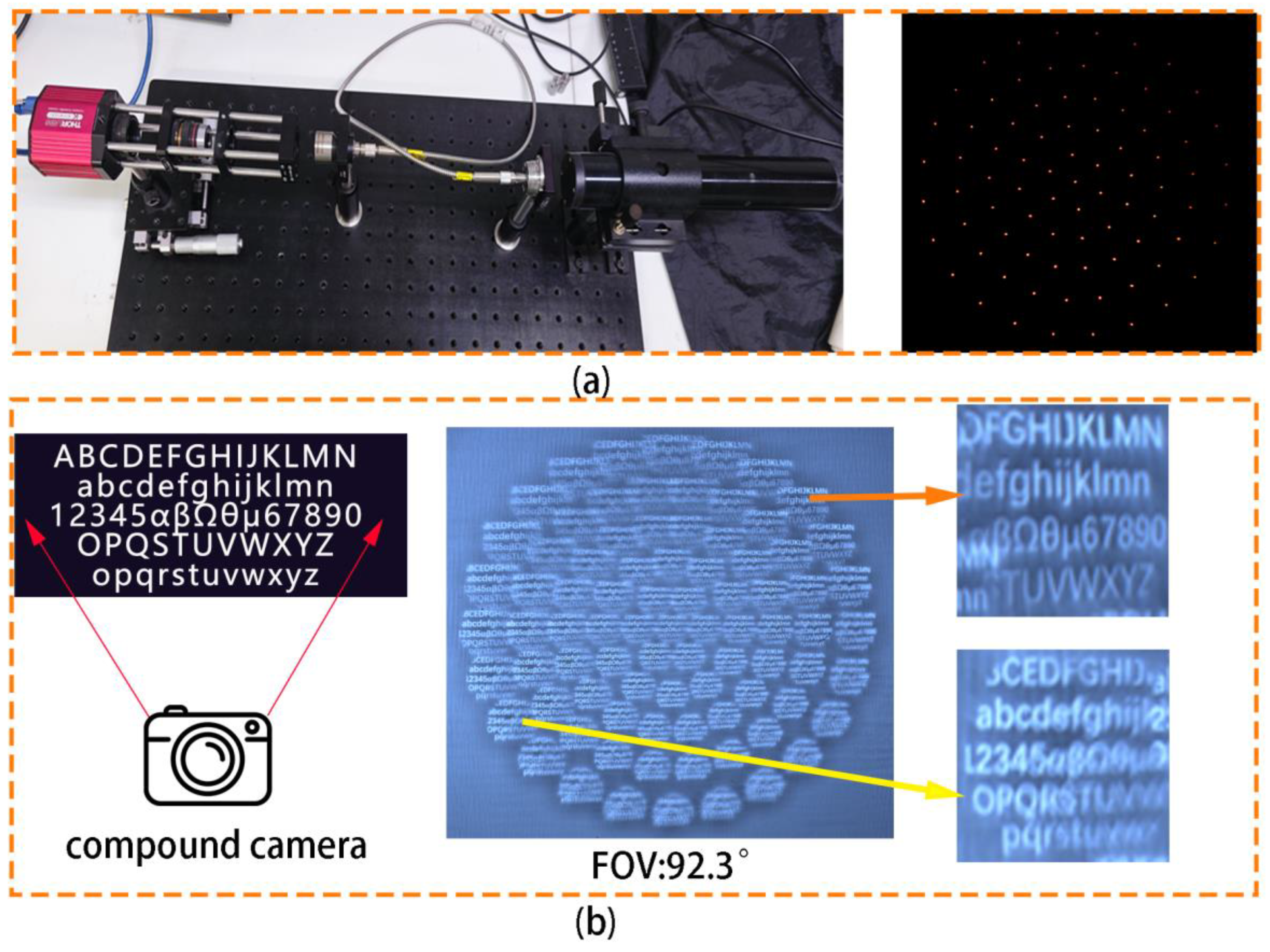
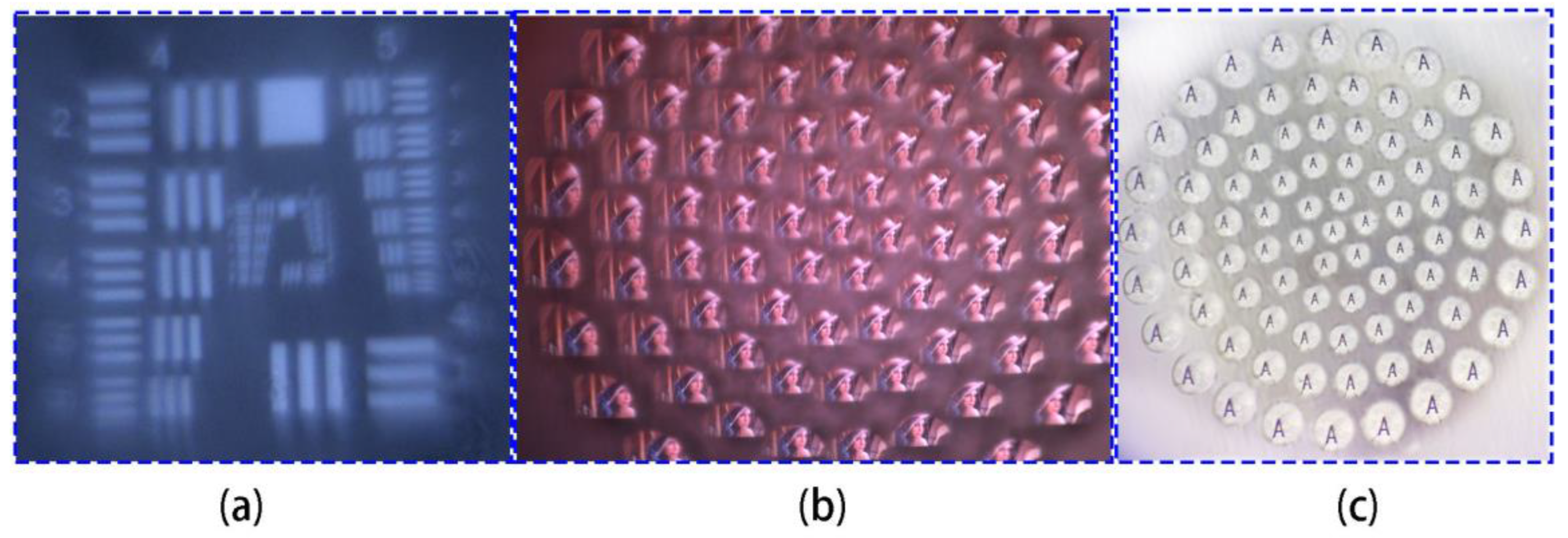
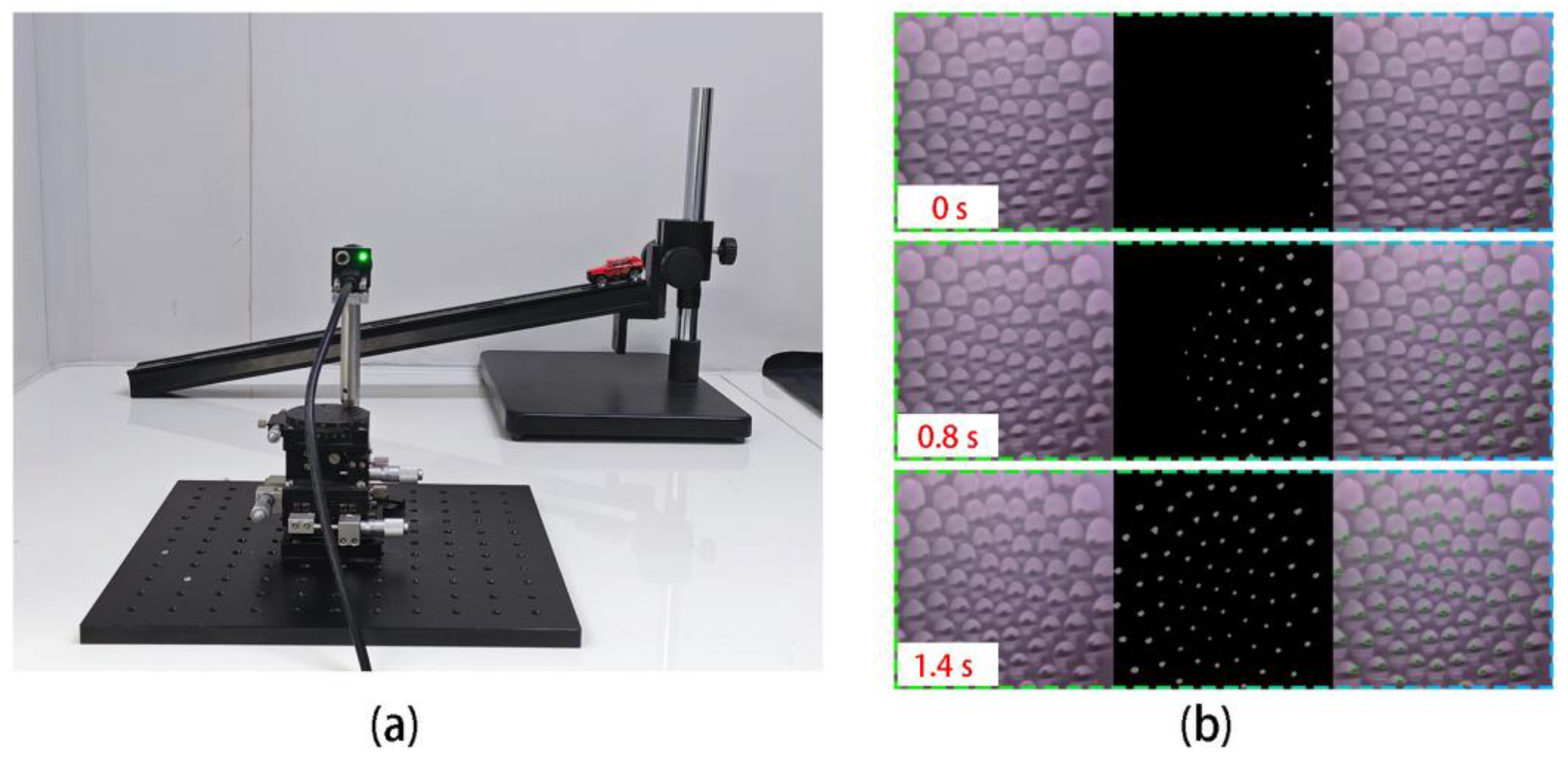
Disclaimer/Publisher’s Note: The statements, opinions and data contained in all publications are solely those of the individual author(s) and contributor(s) and not of MDPI and/or the editor(s). MDPI and/or the editor(s) disclaim responsibility for any injury to people or property resulting from any ideas, methods, instructions or products referred to in the content. |
© 2023 by the authors. Licensee MDPI, Basel, Switzerland. This article is an open access article distributed under the terms and conditions of the Creative Commons Attribution (CC BY) license (https://creativecommons.org/licenses/by/4.0/).
Share and Cite
Feng, X.; Lv, X.; Dong, J.; Liu, Y.; Shu, F.; Wu, Y. Double-Glued Multi-Focal Bionic Compound Eye Camera. Micromachines 2023, 14, 1548. https://doi.org/10.3390/mi14081548
Feng X, Lv X, Dong J, Liu Y, Shu F, Wu Y. Double-Glued Multi-Focal Bionic Compound Eye Camera. Micromachines. 2023; 14(8):1548. https://doi.org/10.3390/mi14081548
Chicago/Turabian StyleFeng, Xin, Xiao Lv, Junyu Dong, Yongshun Liu, Fengfeng Shu, and Yihui Wu. 2023. "Double-Glued Multi-Focal Bionic Compound Eye Camera" Micromachines 14, no. 8: 1548. https://doi.org/10.3390/mi14081548





